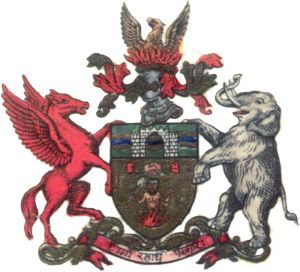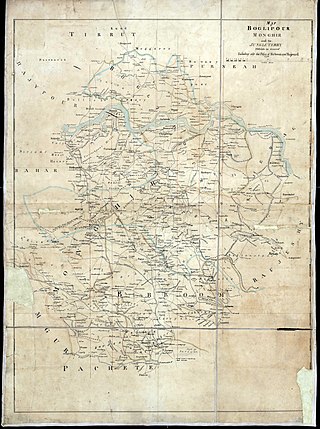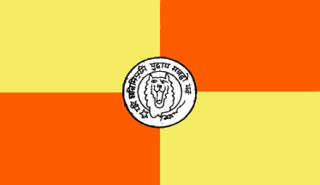
Buxar district is one of the 38 districts of Bihar, India. Located in the southwestern part of the state, it is a primarily agricultural district. The district headquarters is at the town of Buxar. Buxar district was carved out from Bhojpur district on 17 March 1991.

Arrah is a city and a municipal corporation in Bhojpur district in the Indian state of Bihar. It is the headquarters of Bhojpur district, located near the confluence of the Ganges and Sone rivers, some 24 mi (39 km) from Danapur and 36 mi (58 km) from Patna.

Dumraon is a town, near Buxar city and nagar parishad corresponding community development block in Buxar district in the Indian state of Bihar. Historically, it was the capital of the Dumraon Raj.
The Darbhanga Raj, also known as Raj Darbhanga and the Khandwala dynasty, was a Maithil Brahmin dynasty and the rulers of territories, not all contiguous, that were part of the Mithila region, now divided between India and Nepal.

Bhojpur district is one of the 38 districts of the Indian state of Bihar. Arrah city is the administrative headquarters of this district. Bhojpur district came into existence in 1972. Earlier it was the part of Shahabad district. This district is named "Bhojpur" after great Parmara King Bhoja as most early settlers were Rajput rulers of Parmara dynasty then called as Ujjainiya.

The Sonbarsa Raj was a medieval chieftaincy and later a zamindari (estate) during British Raj in modern-day Bihar, in erstwhile Bhagalpur district. It was controlled by the Gandhavariya Rajputs.

Jagdishpur is a nagar panchayat town of the district Bhojpur of the state of Bihar in eastern India. It was the capital of the eponymous Jagdishpur Raj ruled by Rajputs of the Ujjainiya clan. One of its rulers, Kunwar Singh, was a major figure in the Indian Rebellion of 1857, considered the leader of the rebellion in Bihar.

The Ujjainiya or Ujjainia is a clan of Rajputs mainly found in Bihar and Purvanchal. They are an off-shoot of Paramara dynasty of Malwa. The Ujjainiya dynasty historically ruled over the parts of Bhojpuri region during the medieval era. They were mainly rulers and aristocrats holding major power of the region.
Purbiya was a common term used in medieval India for Rajput and Brahmin mercenaries and soldiers from the eastern Gangetic Plain - areas corresponding to present-day western Bihar and eastern Uttar Pradesh. The Purbiyas played a significant role in the militaries of various principalities in Western India including the Marwar army as well at the Gujarat Sultanate and Malwa Sultanate.
The Battle of Chausa was a notable military engagement between the Mughal Emperor, Humayun, and the Afghan warlord, Sher Shah Suri. It was fought on 26 June 1539 at Chausa, 10 miles southwest of Buxar in modern-day Bihar, India. Sher Shah Suri was assisted by his allies, the Ujjainiya Rajputs of Bhojpur and Gautam Rajputs who were led by the commander, Gajpati Ujjainia. Humayun escaped from the battlefield to save his life. Sher Shah was victorious and crowned himself Farīd al-Dīn Shēr Shāh. Babur's cousin, Mirza Haidar asserted that the armies might have numbered over 200,000 troops.
Maharaja Fateh Bahadur Shahi was the 99th Baghochia Raja of Huseypur, today situated in the Gopalganj district of Bihar, India, and which controlled parts of present day Saran, Siwan, Gopalganj, and Buxar districts of Bihar and some districts of Uttar Pradesh. He relentlessly pursued his objective of driving them out for nearly three decades while waging a guerilla war against the British. Maharaja Fateh Bahadur Shahi finally lost the battle with British forces due to large numbers of traitors from Rajput community who had joined British forces and fought against their own King under the leadership of Dhajju Singh Rajput. Local muslim warriors had provided outstanding assistance to Maharaja Fateh Bahadur Shahi and joined his army. Muslims soldiers had fought against British soldiers under leadership of Maharaja Fateh Bahadur Sahi. Yadava, kurmi, koiri and Sahani had also joined the army of Maharaja Fateh Bahadur Sahi to strengthen him. Maharaja of Huseypur, Saran had migrated to Gorakhpur after losing battle against British forces. The British used all of their might and resources to oppose him.
Rajputs in Bihar are members of the Rajput community living in the eastern Indian state of Bihar. They traditionally formed part of the feudal elite in Bihari society. Rajputs were pressed with the Zamindari abolition and Bhoodan movement in post-independence India; along with other Forward Castes, they lost their significant position in Bihar's agrarian society, leading to the rise of Other Backward Classes (OBCs).
Raja Horil Singh was a ruler of Dumraon belonging to the Ujjainiya dynasty.

Kharagpur Raj was a prominent chieftaincy, founded in the early 16th century in Bihar situated mainly in modern-day Munger district. They were notable for being one of the few chieftaincies in Bihar to convert to Islam and many of the rulers became firm allies of the Mughal authorities. At its peak, the Kharagpur Raj encompassed parts of the modern-day districts of Munger, Bhagalpur, Jamui, Lakhisarai, Godda and Deoghar. Due to its size, the Privy Council compared it with the Kingdom of Sardinia.
The Chero dynasty or Chyavana dynasty was a polity that ruled the northern regions of the Indian subcontinent, corresponding to the present-day Indian states of Bihar, Uttar Pradesh, and Jharkhand, after the fall of the Pala Empire; their rule lasted from the 12th century CE to the middle of the 15th century.

The Zamindars of Bihar were the autonomous and semi-autonomous rulers and administrators of the subah of Bihar during Mughal rule and later during British rule. They formed the landed aristocracy that lasted until Indian independence in 1947. The zamindars of Bihar were numerous and could be divided into small, medium and large depending on how much land they controlled. Within Bihar, the zamindars had both economic and military power. Each zamindari would have their own standing army which was typically composed of their own clansmen.

The Jagdishpur Raj was a feudatory zamindari ruled by a cadet branch of the Ujjainiya dynasty. It was situated in modern-day Jagdishpur, in the erstwhile Shahabad district of Bihar. The capital of the principality was the town of Jagdishpur by which the principality derived its name.

The Gidhaur Chieftaincy was a principality which controlled parts of South Bihar for much of the medieval period in India. The chieftaincy was named after the town of Gidhaur in Jamui district but its territory extended into the wider region.

Bhojpur Kadim is a historic village in Dumraon block of Buxar district, Bihar, India. As of 2011, its population was 18,243, in 3,024 households. Together with the neighboring Bhojpur Jadid, it lends its name to the surrounding Bhojpuri region.
Raja Gajpati Ujjainia, also known as Raja Gajpati Sahi was a ruler of Bhojpur belonging to the Ujjainiya dynasty.













